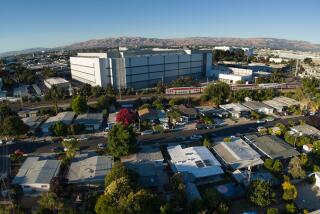In Cambria, they can’t hear you now
- Share via
CAMBRIA, CALIF. -- — Sharon Vaughan had been warned that cellphone reception was notoriously bad in this wealthy Central Coast town of art boutiques and touristy shops selling pottery and seashells.
But the reality of cellularless living didn’t really sink in until she moved to her first apartment in town two years ago.
“The only place I could get a call out was on a wooden deck outside my apartment,” said Vaughan, a restaurant manager at Cambria Pines Lodge. “And it only worked if I looked straight into my neighbor’s window. He wasn’t too thrilled.”
Odd contortions have become a way of life in Cambria, a town of 6,500 artists, musicians and retirees in which hilly terrain combines with a single cell tower to create frustratingly spotty service.
“It’s an electromagnetic black hole, from the moment you enter Cambria until the moment you leave,” said Ken Cumings, a retired engineer.
Dead service zones are nothing new, of course. Cellphone users in such spots as Palos Verdes, the Hollywood Hills and Malibu frequently complain about bad service, according to Jeff Cohn, whose website, deadcellzones.com, has been cataloging bad coverage nationwide since 2000.
But though coverage has improved dramatically in the Los Angeles metropolitan area and other populous regions, pockets of poor reception still exist in the state’s more remote areas, analysts say.
In Cambria, residents are getting impatient.
“There is a tendency to take your phone and fling it,” said Kathe Tanner, a reporter for the Cambrian, the local newspaper, who owns phones from two carriers to increase her odds of being able to make calls while on the job.
Even with two phones, she can complete a call only half of the time, she says.
It’s not only locals who get frustrated. Tourism is the town’s biggest industry, and visitors often aren’t happy to learn they can’t check on home from a local cafe or beach.
They often can be spotted standing smack in the middle of streets, staring at their phones in search of bars.
Emily Murphy, who tends the front desk at Cambria Pines Lodge, said a middle-aged woman recently came to her desk and dramatically flung down her purse.
“We didn’t know what was wrong. Then she looked me in the eye and screamed, ‘I can’t get a call out, and I’m going crazy!’ ”
Residents say their town should have caught up with the rest of California years ago.
But attempts to erect cell towers have been held up for five years -- largely because of complaints about potential environmental harm. “It just burns me up,” said Cumings, the retired engineer. “It’s the tyranny of the few. The majority of Cambrians want and need cellphone service.”
The California Coastal Commission and two local environmental groups have protested the placement of towers on Fiscalini Ranch, a 430-acre forested property that sits high above downtown. Sprint Nextel, which wants to provide service, has offered to disguise the towers in two artificial pine trees.
The company says the site is the best place to install towers, and that putting them there would dramatically improve cellular service for the 3-square-mile town.
But critics say the publicly owned ranch should remain undeveloped, used only by hikers and others seeking respite in nature. Cell towers, even those masquerading as trees, would mar the property, they say.
“Putting up faux pine trees is pretty silly,” said Richard Hawley, executive director of Green Space-The Cambria Land Trust, a nonprofit group that is protesting Sprint Nextel’s plan. “They are taking out real pine trees and putting up fake trees that are 80 feet tall. It’s an assault on public property.”
Green Space and another environmental group, Land Watch, are asking Sprint Nextel to find an alternative site for towers.
This week, the San Luis Obispo County Board of Supervisors appeared sympathetic to their concerns.
After a public hearing, supervisors delayed for two months a decision on whether to approve the towers, instructing Sprint Nextel to use the time to investigate other sites.
Locals, meanwhile, cope as they can, sometimes driving north toward Hearst Castle or south toward Pismo Beach to get a signal. They swap information on good spots for cell reception like recipes, Tanner said.
One such spot is Green Street, in a residential neighborhood on the south side of town, where drivers often pull over to make calls.
“It’s a little pocket of good reception,” Tanner said. “You’ll see several cars on the same block, with cellphones clamped to the drivers’ ears.”
Cambria Pines Lodge has received so many complaints over the years that managers finally installed a cellular booster on its roof. It doesn’t work perfectly, but it does make it easier for some customers to get and make calls, said Vaughan, the restaurant manager.
“There’s one spot in our parking lot that seems to work well for most providers,” she said. “We’re thinking about painting a big circle there and just directing people to it.”
An industry trade group said coverage nationwide has improved in recent years, thanks to a significant increase in cell towers.
In 2000, there were 95,733 cell sites across the nation. By last June, the number had grown to 210,000, said Joe Farren of CTIA, the telecommunications industry’s trade group.
Carriers work with communities to find tower sites that are acceptable, Farren said. Cambria’s sole existing cellular tower, for instance, is inside the church steeple of Santa Rosa Catholic Church, which needed restoration when Cellular One came along. The company footed the bill and pays monthly rent. The tower is not visible from outside.
Wireless calls use radio technology, and cellphone users must be within the line of sight of antennas to get good reception, Farren said.
“You can’t have communications traveling through the air without towers to catch the signal,” he said. The desire for improved service is strong. But it’s hardly universal, even among those who don’t mind if more towers come in.
Jo Ellen Butler, executive director of the nonprofit group that manages Fiscalini Ranch, said she has no objection to installing towers on the ranch, which would receive monthly income from them. But she’s never had a cellphone and prefers it that way.
“I’ll probably get there at some point. But I kind of like being unreachable sometimes,” she said.
On a recent rainy weekday, Judy Langholz, who works for a telecom company in Des Moines, checked in at the Fireside Inn on nearby Moonstone Beach.
The staff told her right away about the poor cell service.
“Sweet!” she said with a smile. “I’m on vacation.”
catherine.saillant
@latimes.com
More to Read
Sign up for Essential California
The most important California stories and recommendations in your inbox every morning.
You may occasionally receive promotional content from the Los Angeles Times.











